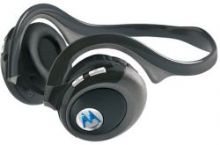Moto's HT820 Bluetooth headset is 'in the mail'


But one Bluetooth profile that the Q is one of the first handsets to support is A2DP. The A2DP profile allows the handset to connect to a set of A2DP-compliant headgear that doubles as both a hands-free headset (for hands-free talking on the cell phone) and a wireless set of stereo headphones for music and video playback. In most cases, when stereo audio is playing through an A2DP-compliant handset wirelessly to AD2P-compliant headgear and a phone call comes in, the audio will automatically interrupt itself so you can take the call and resume when the call is over.
As much as I'm not to crazy about Bluetooth, I am pretty jazzed about trying this feature out for a couple of reasons. First, I don't want two separate devices for my head (one for stereo audio and another for a wireless hand-free headset). Second, although the at-the-ear specific absorption rate (SAR) rating is relatively low compared to other phones on the market (1.11 watts/kg out of a maximum allowed value in the US and Canada of 1.6 W/kg), I still see using Bluetooth headsets with their significantly weaker radios (than the broadband wireless one that has to communicate to some cell tower that's who knows how many miles away) as a better option than holding a cell phone -- any cell phone -- next too your head.
That said, I've been told by researchers that the potential cancer risk (nothing has been unequivocally proven yet, but then again, nothing has been unequivocally disproven) is not necessarily related to just to the strength of the radio, but rather the strength and the time of exposure. So, theoretically (and no studies have been done), wearing a Bluetooth radio on your ear for very prolonged periods of time could produce an exposure that's similar to a cell phone being held close to the ear for shorter periods across the day. Again, the jury is pretty much out on all wireless technologies which is why I think (a) the weaker radio is the better one to have near your head and (2) it's better to be safe than sorry -- you probably don't need to keep it on and hanging on your ear the entire time. For more about my feelings on cell phones and cancer, see my coverage from earlier this year that also links to other coverage I've done on the topic. Also, as a side note, the Q's at-the-body SAR rating is 1.47 W/kg (a little closer to the 1.6 W/kg max). In other words, keep it (and other cell phones too) out if you can.
I've digressed. So, in hopes of giving the A2DP functionality a whirl, I've ordered Motorola's HT820 Bluetooth Headset (pictured above left) and it's expected to be here tomorrow. Googling "Motorola HT820" surfaced three (obviously paid) links at the top one of which was inaccurate, another of which had the item for $54.99 but it was out-of-stock and a third (Erwincomp.com) that had it for $69.95. The retail price is $140 and a cursory pass at all other offerings showed the same item was for sale in the $80-$95 range so I dropped my cash with Erwincomp and the item is supposed to get here tomorrow. In my ongoing coverage of the Motorola Q, I'll let you know how they work out.